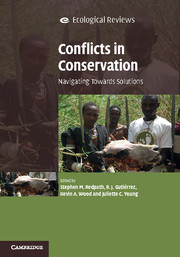Book contents
- Frontmatter
- Dedication
- Contents
- List of contributors
- Foreword by Georgina Mace
- Acknowledgements
- Part I Introduction to conservation and conflict
- PART II Contrasting disciplinary approaches to the study of conflict in conservation
- Part III Approaches to managing conflicts
- 14 Modelling conservation conflicts
- 15 Defining scales for managing biodiversity and natural resources in the face of conflicts
- 16 Mediation and conservation conflicts: from top-down to bottom-up
- 17 Designing and facilitating consensus-building – keys to success
- 18 Conservation conflict transformation: the missing link in conservation
- 19 Legislated collaboration in a conservation conflict: a case study of the Quincy Library Group in California, USA
- 20 Finding a way out of conservation conflicts
- Index
- Plate Section
- References
20 - Finding a way out of conservation conflicts
from Part III - Approaches to managing conflicts
Published online by Cambridge University Press: 05 May 2015
- Frontmatter
- Dedication
- Contents
- List of contributors
- Foreword by Georgina Mace
- Acknowledgements
- Part I Introduction to conservation and conflict
- PART II Contrasting disciplinary approaches to the study of conflict in conservation
- Part III Approaches to managing conflicts
- 14 Modelling conservation conflicts
- 15 Defining scales for managing biodiversity and natural resources in the face of conflicts
- 16 Mediation and conservation conflicts: from top-down to bottom-up
- 17 Designing and facilitating consensus-building – keys to success
- 18 Conservation conflict transformation: the missing link in conservation
- 19 Legislated collaboration in a conservation conflict: a case study of the Quincy Library Group in California, USA
- 20 Finding a way out of conservation conflicts
- Index
- Plate Section
- References
Summary
The world is undergoing rapid change from increasing human pressure. The scale and intensity of this change are deeply worrying from a conservation perspective. For example, we see severe threats to species, habitat and ecosystems from poaching (Maisels et al., 2013), the illegal use of poison (Ogada, 2014), overharvesting (Pinsky and Palumbi, 2014) and agricultural expansion (Laurance et al., 2014). In this book we have focused on how those who represent conservation arguments (conservationists) can respond to these types of challenges. These conservation conflicts arise because one side is passionate about the need to conserve biological diversity, whether for moral, intrinsic or anthropocentric reasons, and the other side may be more focused on different objectives related to human livelihoods and well-being. That is not to say that those arguing for human livelihoods do not recognise the need to conserve biodiversity, and vice versa, but each side may question the relative importance of the arguments, or the specific objectives, or the methods used to achieve those objectives. What is clear is that conservationists are antagonists in these conflicts, and this realisation is important because in order to navigate a path out of destructive conflict, conservationists will need to recognise their role in these issues, address the roots of the problem and be clear about their objectives and about how they engage with the other parties (Redpath et al., 2014).
Throughout the book, we have presented a range of richly complex and multilayered examples. Each has its own idiosyncrasies, but together they expose general principles and highlight what is needed to map and manage conservation conflicts. In this final chapter we build on these perspectives and draw out the principles and steps towards collaborative conflict management. While we recognise that conflicts may be a force for good (Coser, 1956), the conflicts presented here are more often damaging and costly both to humans and biodiversity.
- Type
- Chapter
- Information
- Conflicts in ConservationNavigating Towards Solutions, pp. 287 - 303Publisher: Cambridge University PressPrint publication year: 2015
References
- 3
- Cited by



